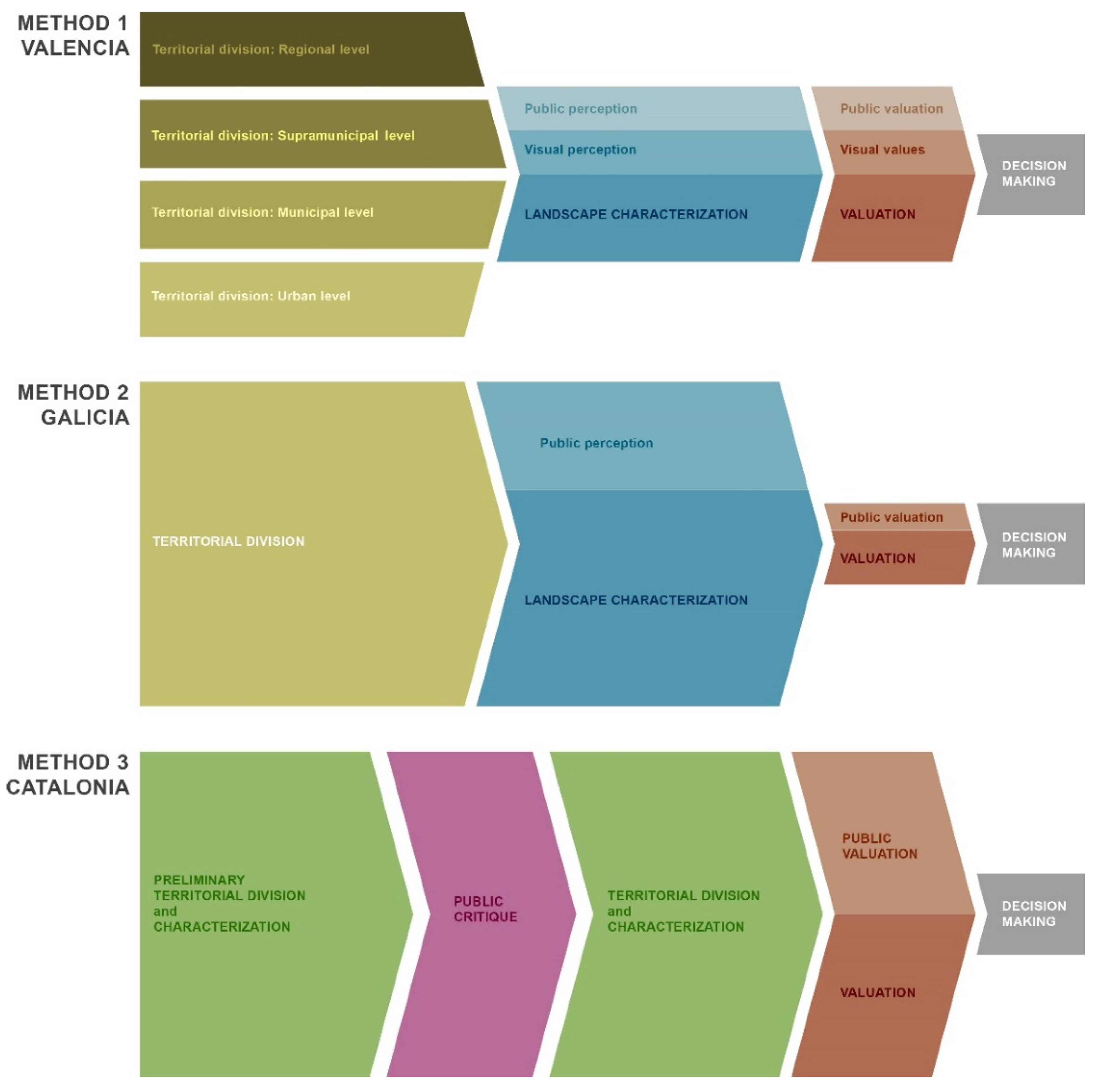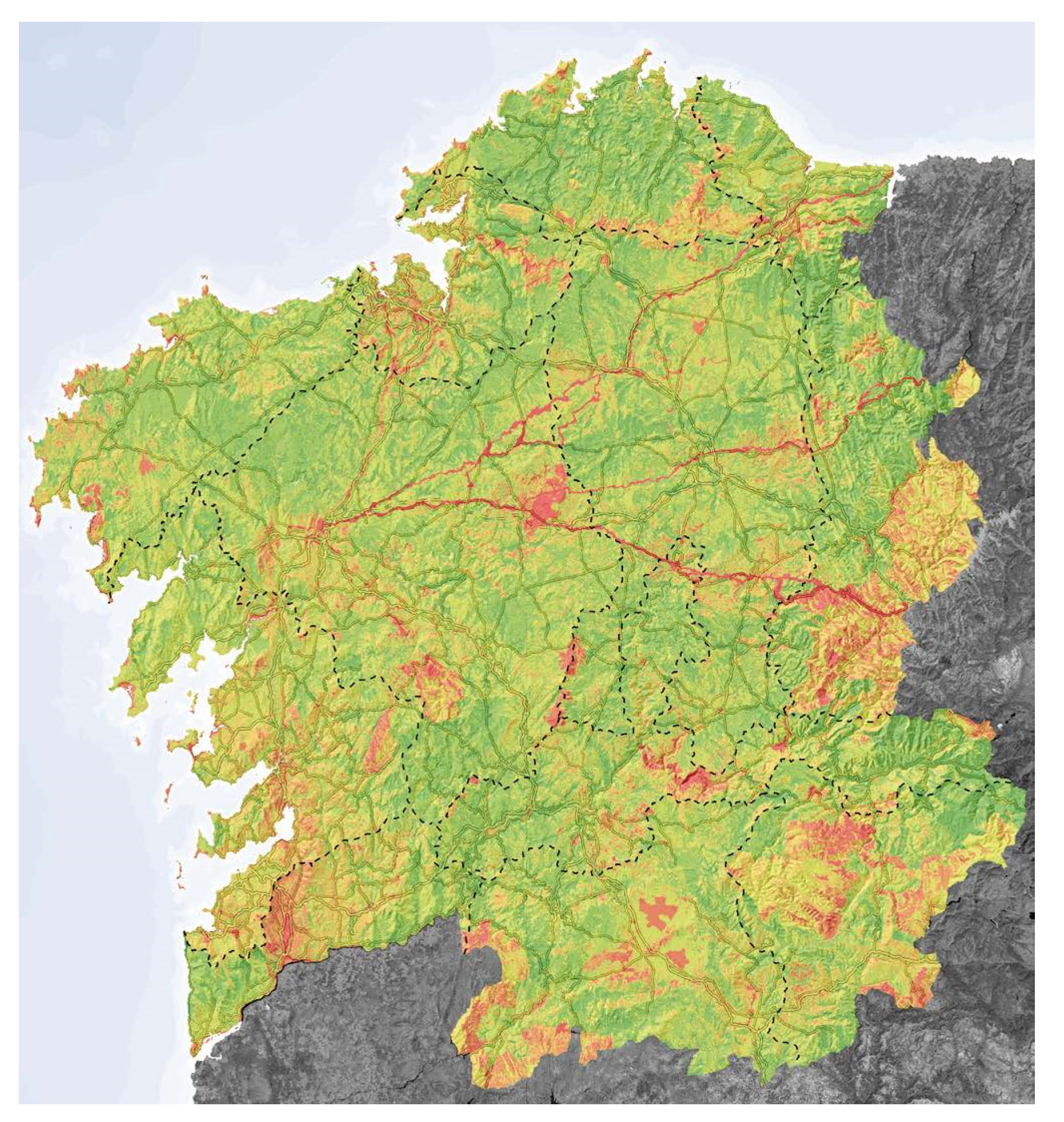Landscape Assessment Methods Derived from the European Landscape Convention: Comparison of Three Spanish Cases
Abstract
:1. Introduction
- To study the different methodological possibilities of landscape understanding and evaluation opened by the ELC.
- To compare the strengths and weaknesses of each method.
- To determine which actions are most appropriate for landscape governance in relation to the demands of territorial sustainability and involvement of the population.
2. Materials and Method
2.1. Case Studies
2.1.1. Methodological Guide of Landscape Study of the Generalitat Valenciana
2.1.2. Catalog of Galician Landscapes
2.1.3. Landscape Catalogs in Catalonia: Method
2.2. Method
3. Results
3.1. Methodology Comparisson
3.2. Phases Comparisson
3.2.1. Landscape Units
3.2.2. Characterization and Evaluation
3.2.3. Visual Perception and Public Participation
4. Discussion
5. Conclusions
Funding
Institutional Review Board Statement
Informed Consent Statement
Data Availability Statement
Conflicts of Interest
References
- International Union for Conservation of Nature (IUCN). Guidelines for Protected Area Management Categories; IUCN: Gland, Switzerland; Cambridge, UK, 1994. [Google Scholar]
- United Nations Educational, Scientific and Cultural Organization (UNESCO). Convention Concerning the Protection of the World Cultural and Natural Heritage. In Proceedings of the World Heritage Committee Sixteenth Session, Santa Fe, NM, USA, 7–14 December 1992; UNESCO: Santa Fe, NM, USA, 1992. [Google Scholar]
- Council of Europe. European Landscape Convention; Council of Europe Publishing Division: Strasbourg, France, 2000. [Google Scholar]
- Déjeant-Pons, M. The environmental, cultural, social and economic dimensions of the landscape. A look at current experiences on the threshold of the 20th anniversary of the adoption of the Convention. Econ. Cult. 2019, 3, 357–370. [Google Scholar] [CrossRef]
- Déjeant-Pons, M. The European Landscape Convention. Landsc. Res. 2006, 31, 363–384. [Google Scholar] [CrossRef]
- Scott, A. Beyond the conventional: Meeting the challenges of landscape governance within the European Landscape Convention? J. Environ. Manag. 2011, 92, 2754–2762. [Google Scholar] [CrossRef] [PubMed]
- De Montis, A. Impacts of the European Landscape Convention on national planning systems: A comparative investigation of six case studies. Landsc. Urban Plan. 2014, 124, 53–65. [Google Scholar] [CrossRef]
- García-Martín, M.; Bieling, C.; Hart, A.; Plieninger, T. Integrated landscape initiatives in Europe: Multi-sector collaboration in multi-functional landscapes. Land Use Policy 2016, 58, 43–53. [Google Scholar] [CrossRef] [Green Version]
- Janssen, J. Sustainable development and protected landscapes: The case of The Netherlands. Int. J. Sustain. Dev. World Ecol. 2009, 16, 37–47. [Google Scholar] [CrossRef] [Green Version]
- Terra, T.N.; dos Santos, R.F.; Costa, D.C. Land use changes in protected areas and their future: The legal effectiveness of landscape protection. Land Use Policy 2014, 38, 378–387. [Google Scholar] [CrossRef]
- De Montis, A. Measuring the performance of planning: The conformance of Italian landscape planning practices with the European Landscape Convention. Eur. Plan. Stud. 2016, 24, 1727–1745. [Google Scholar] [CrossRef]
- Jones, M.; Howard, P.; Olwig, K.R.; Primdahl, J.R.; Sarlöv Herlin, I. Multiple interfaces of the European landscape convention. Nor. J. Geogr. 2007, 61, 207–216. [Google Scholar] [CrossRef]
- Council of Europe. Chart of Signatures and Ratifications of Treaty 176. Available online: https://www.coe.int/en/web/conventions/full-list?module=signatures-by-treaty&treatynum=176 (accessed on 12 February 2022).
- Council of Europe. Reservations and Declarations for Treaty No.176—Council of Europe Landscape Convention (ETS No. 176). Available online: https://www.coe.int/en/web/conventions/full-list?module=declarations-by-treaty&numSte=176&codeNature=4&codePays=DEN (accessed on 12 February 2022).
- Roe, M. Policy Change and ELC Implementation: Establishment of a Baseline for Understanding the Impact on UK National Policy of the European Landscape Convention. Landsc. Res. 2013, 38, 768–798. [Google Scholar] [CrossRef]
- Janssen, J.; Knippenberg, L.W.J. From landscape preservation to landscape governance: European experiences with sustainable development of protected landscapes. In Studies on Environmental and Applied Geomorphology; Piacentini, T., Miccadei, E., Eds.; IntechOpen: London, UK, 2012; pp. 241–266. [Google Scholar] [CrossRef]
- Jones, M. The European Landscape Convention and the question of public participation. Landsc. Res. 2007, 32, 613–633. [Google Scholar] [CrossRef]
- de Patrimonio Histórico, C. Plan Nacional de Paisaje Cultural [National Plan for Cultural Landscape]; Gobierno de España: Madrid, Spain, 2012. [Google Scholar]
- Osservatorio nazionale per la qualità del paesaggio. Carta Nazionale del Paesaggio. Elementi per una Strategia per il Paesaggio Italiano; Gangemi Editore spa: Rome, Italy, 2018. [Google Scholar]
- Borger, G.J.; de Jong, E.A.; de Snoo, G.R.; Stortelder, A.H.F.; Heijdeman, B.J. Landschapsmanifest. The Netherlands, 2005. Available online: https://edepot.wur.nl/118345 (accessed on 12 February 2022).
- Government of the Netherlands, Ministerie van Infrastructuur en Milieu. Environment and Planning Act—Explanatory Memorandum; Ministerie van Infrastructuur en Milieu: The Hague, The Netherlands, 2017. Available online: https://www.government.nl/binaries/government/documenten/reports/2017/02/28/environment-and-planning-act-%E2%80%93-explanatory-memorandum/EnglishtranslationExplanatorMemorandumEnvironmentAct.pdf (accessed on 12 February 2022).
- Swiss Confederation, Federal Office for the Environment. Swiss Landscape Concept. Landscape and Nature in Federal Policy Areas; Federal Office for the Environment: Bern, Switzerland, 2020. [Google Scholar]
- Fairclough, G.; Herlin, I.S.; Swanwick, C. Landscape Character Approaches in Global, Disciplinary and Policy Context: An Introduction. In Routledge Handbook of Landscape Character Assessment. Current Approaches to Characterisation and Assessment; Fairclough, G., Herlin, I.S., Swanwick, C., Eds.; Routledge: London, UK; New York, NY, USA, 2018; pp. 3–20. [Google Scholar]
- Sandström, U.G.; Hedfors, P. Uses of the word ‘landskap’ in Swedish municipalities’ comprehensive plans: Does the European Landscape Convention require a modified understanding? Land Use Policy 2018, 70, 52–62. [Google Scholar] [CrossRef]
- Marine, N.; Arnaiz-Schmitz, C.; Herrero-Jáuregui, C.; de la O Cabrera, M.R.; Escudero, D.; Schmitz, M.F. Protected Landscapes in Spain: Reasons for Protection and Sustainability of Conservation Management. Sustainability 2020, 12, 6913. [Google Scholar] [CrossRef]
- De la O Cabrera, M.R.; Marine, N.; Escudero, D. Spatialities of cultural landscapes: Towards a unified vision of Spanish practices within the European Landscape Convention. Eur. Plan. Stud. 2020, 28, 1877–1898. [Google Scholar] [CrossRef]
- Muñoz Criado, A. Guía Metodológica de Estudio de Paisaje; Conselleria de Infraestructuras, Territorio y Medio Ambiente: Valencia, Spain, 2012. [Google Scholar]
- Instituto do Estudios do Territorio. Catálogo das Paisaxes de Galicia; Xunta de Galicia: Santiago de Compostela, Spain, 2016. [Google Scholar]
- Nogué, J.; Sala, P.; Grau, J. Los Catálogos de Paisaje de Cataluña: Metodología; Observatorio del Paisaje de Cataluña: Olot, Spain, 2018. [Google Scholar]
- Rivas-Martínez, S.; Rivas-Saenz, S.; Penas, A. Worldwide Bioclimatic Classification System; Backhuys Pub.: Kerkwerve, The Netherlands, 2002. [Google Scholar]
- Nogué, J.; Sala, P. Landscape, Local Knowledge and Democracy: The Work of the Landscape Observatory of Catalonia. In Routledge Handbook of Landscape Character Assessment. Current Approaches to Characterisation and Assessment; Fairclough, G., Herlin, I.S., Swanwick, C., Eds.; Routledge: London, UK; New York, NY, USA, 2018; pp. 265–279. [Google Scholar]
- Dempsey, K.E.; Wilbrand, S.M. The role of the region in the European Landscape Convention. Reg. Stud. 2017, 51, 909–919. [Google Scholar] [CrossRef]
- Swanwick, C.; Fairclough, G. Landscape Character: Experience from Britain. In Routledge Handbook of Landscape Character Assessment. Current Approaches to Characterisation and Assessment; Fairclough, G., Herlin, I.S., Swanwick, C., Eds.; Routledge: London, UK; New York, NY, USA, 2018; pp. 21–36. [Google Scholar]
- Swanwick, C. Landscape Character Assessment. Guidance for England and Scotland. The Countryside Agency: Gloucestershire; Scottish Natural Heritage: Edinburgh, UK, 2002. [Google Scholar]
- Solecka, I.; Raszka, B.; Krajewski, P. Landscape analysis for sustainable land use policy: A case study in the municipality of Popielów, Poland. Land Use Policy 2018, 75, 116–126. [Google Scholar] [CrossRef]
- Krajewski, P.; Solecka, I. Management System of Urban Landscape in Poland on the Example of Wroclaw in the Context of European Landscape Convention Implementation. In IOP Conference Series: Materials Science and Engineering 471 (11); IOP Publishing: Bristol, UK, 2019; p. 112035. [Google Scholar]
- European Rural Architecture. Legislation in Poland. In Rural Architecture in Europe between Tradition and Innovation; Moretti, G., Ed.; Alinea Editrice: Firenze, Italy, 2005; Available online: http://www.pg.gda.pl/architektura/eurarc/pdf/polska/PLnorms.pdf (accessed on 12 February 2022).
- Tudor, C. An Approach to Landscape Character Assessment; Natural England: York, UK, 2014. [Google Scholar]
- Banko, G. Assessing and monitoring nature protection value of European landscapes using remote sensing and GIS tools. In Proceedings of the Space and Time-GIS and Remote Sensing Conference, Sopron, Hungary, 6–8 September 2001. [Google Scholar]
- Mücher, S.; Wascher, D. European landscape characterisation. In Europe’s Living Landscapes: Essays Exploring Our Identity in the Countryside; Pedroli, B., van Doorn, A., de Blust, G., Eds.; KNNV Publishing: Zeit, Germany, 2007; pp. 36–47. [Google Scholar]
- Van Eetvelde, V.; Antrop, M. Landscape character assessment in Belgium: Balancing natural and cultural properties. In Proceedings of the Mobiliteit, Maatschappij en Milieu in Kaart Gebracht, De Belgische Geografendagen, Bevas, deel II, Gent, Belgium, 9 November 2005; Société belge d’études géographiques: Brussels, Belgium, 2005; pp. 347–353. [Google Scholar]
- Wascher, D.M. European Landscape Character Areas: Typologies, Cartography and Indicators for the Assessment of Sustainable Landscapes; No. 1254; Landscape Europe: Wageningen, The Netherlands, 2005. [Google Scholar]
- Smiraglia, D.; Ceccarelli, T.; Bajocco, S.; Perini, L.; Salvati, L. Unraveling landscape complexity: Land use/land cover changes and landscape pattern dynamics (1954–2008) in contrasting peri-urban and agro-forest regions of northern Italy. Environ. Manag. 2015, 56, 916–932. [Google Scholar] [CrossRef] [PubMed]
- United Nations. 11. Sustainable Cities and Communities; UN: New York, NY, USA, 2018. [Google Scholar]


| Method | Functional Orientation | Division of the Territory | Landscape Characterization | Valuation | Perception Analysis |
|---|---|---|---|---|---|
| VALENCIA |
|
|
|
|
|
|
| ||||
| GALICIA |
|
|
|
|
|
| CATALONIA |
|
|
|
|
|
| Instrument | Participants | Phase | Application |
|---|---|---|---|
| Telephone survey | General population | All | Specific units |
| Opinion survey | General population | All | Specific units |
| Web consultation | General population | All | All units |
| Interview to experts | Experts and professionals | All | All units |
| Focus groups | Experts and professionals | Valuation | Specific units |
| Experts’ workshops | Experts and professionals | Valuation | Specific units |
| Citizen’s workshops | General population | Valuation | Specific units |
| Open workshops | General population | All | Specific units |
Publisher’s Note: MDPI stays neutral with regard to jurisdictional claims in published maps and institutional affiliations. |
© 2022 by the author. Licensee MDPI, Basel, Switzerland. This article is an open access article distributed under the terms and conditions of the Creative Commons Attribution (CC BY) license (https://creativecommons.org/licenses/by/4.0/).
Share and Cite
Marine, N. Landscape Assessment Methods Derived from the European Landscape Convention: Comparison of Three Spanish Cases. Earth 2022, 3, 522-536. https://doi.org/10.3390/earth3020031
Marine N. Landscape Assessment Methods Derived from the European Landscape Convention: Comparison of Three Spanish Cases. Earth. 2022; 3(2):522-536. https://doi.org/10.3390/earth3020031
Chicago/Turabian StyleMarine, Nicolas. 2022. "Landscape Assessment Methods Derived from the European Landscape Convention: Comparison of Three Spanish Cases" Earth 3, no. 2: 522-536. https://doi.org/10.3390/earth3020031
APA StyleMarine, N. (2022). Landscape Assessment Methods Derived from the European Landscape Convention: Comparison of Three Spanish Cases. Earth, 3(2), 522-536. https://doi.org/10.3390/earth3020031






